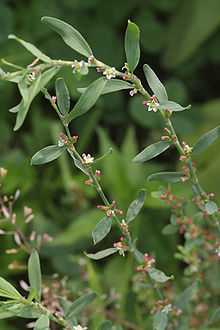Polygonum aviculare
| Common knotgrass | |
|---|---|
 | |
| Polygonum aviculare | |
| Scientific classification | |
| Kingdom: | Plantae |
| (unranked): | Angiosperms |
| (unranked): | Eudicots |
| (unranked): | Core eudicots |
| Order: | Caryophyllales |
| Family: | Polygonaceae |
| Genus: | Polygonum |
| Species: | P. aviculare |
| Binomial name | |
| Polygonum aviculare L. | |
Polygonum aviculare or common knotgrass is a plant related to buckwheat and dock. It is also called birdweed, pigweed and lowgrass. It is an annual found in fields and wasteland, with white flowers from June to October.
Description
Common knotgrass is an annual herb with a semi-erect stem that may grow to 10 to 40 cm (4 to 16 in) high. The leaves are hairless and short-stalked. They are longish-elliptical with short stalks and rounded bases; the upper ones are few and are linear and stalkless. The stipules are fused into a stem-enclosing, translucent sheath known as an ochrea that is membranous and silvery. The flowers are regular, green with white or pink margins. Each has five perianth segments, overlapping at the base, five to eight stamens and three fused carpels. The fruit is a dark brown, three-edged nut. The seeds need light to germinate which is why this plant appears in disturbed soil in locations where its seeds may have lain dormant for years.[1]
Chemistry
P. aviculare contains the flavonols avicularin, myricitrin, juglanin[2], astragalin, betmidin and the lignan aviculin.[3]
Herbalism and folklore
Nicholas Culpeper states that the plant is ruled astrologically by Saturn and Capricorn. He also recommended knotweed to cure the spitting of blood. Modern herbalists use it to treat dysentery, excessive menstrual flow, lung disorders, bronchitis and jaundice, and gall and kidney stones.[citation needed] Not all of these uses are supported by scientific evidence. The plant is an astringent, coagulant, diuretic and expectorant.[citation needed]
Cuisine
In Vietnam, where it is called rau đắng, it is widely used to prepare soup and hot pot, particularly in the South region.
Subspecies
This plant has a wide distribution as an arable weed and plant of fields, shingle, sand, roadsides, yards and waste places. There is much morphological variations among different populations and several different sub-species are recognized:[1]
- Polygonum aviculare subsp. aviculare
- Polygonum aviculare subsp. depressum (Meisn.) Arcang.
- Polygonum aviculare subsp. rurivagum (Jord. ex Boreau) Berher in Louis
References
- ↑ 1.0 1.1 "Knotgrass: Polygonum aviculare". NatureGate. Retrieved 2013-12-30.
- ↑ LC Method for Analysis of Three Flavonols in Rat Plasma and Urine after Oral Administration of Polygonum aviculare Extract. Fuquan Xu, Huashi Guan, Guoqiang Li and Hongbing Liu, Chromatographia, June 2009, Volume 69, Issue 11-12, pages 1251-1258, doi:10.1365/s10337-009-1088-x
- ↑ A Novel Lignan and Flavonoids from Polygonum aviculare. Hyoung Ja Kim, Eun-Rhan Woo and Hokoon Park, J. Nat. Prod., 1994, 57 (5), pages 581–586, doi:10.1021/np50107a003
- Howard, Michael. Traditional Folk Remedies, (Century, 1987); p. 162.
| Wikimedia Commons has media related to Polygonum aviculare. |
| Wikispecies has information related to: Polygonum aviculare |